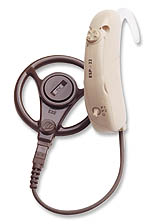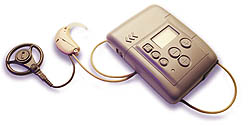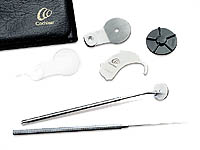What
does the cochlear implant do?
Many people with hearing loss can use hearing aids
to amplify sounds and help them hear. For some people
with severe or profound sensori-neural deafness
hearing aids do not help. These people may make
use of the cochlear implant.
The
cochlear implant replaces the function of the
entire ear. It uses a microphone and directly
stimulates any remaining hearing nerves using
electricity to enable the brain to perceive sound.
How
the cochlea works
The cochlea is arranged so that different sound
frequencies stimulate different hair cells and
nerve fibres. Stimulating hair cells at the base
of the cochlea produces perceptions of high pitched
sounds. Stimulating hair cells at the apex of
the cochlea produces low pitched sounds. The cochlear
implant is designed with electrodes at different
positions so as to stimulate the appropriate hair
cells and improve the perception of sound.
|
The
Cochlear Implant System
The Cochlear Implant System is made up of
two separate parts:
- the
receiver-stimulator and electrodes are
implanted surgically
- the
microphone, speech processor and transmitting
coil are worn outside the body and can
be removed at any time.
The
Cochlear Implant System receives information
in the form of sound and processes this
information into a format suitable for interpretation
by the brain. It uses several different
processes and methods of transmission as
shown in the diagram. The entire process
takes only milliseconds so the person hears
sounds virtually as they occur. The processor
can filter out background noise.
The
current Cochlear Implant System is the Nucleus®
24. Click here for specifications.
|

Click
here to view detailed pdf document |
| 1. |
The
hearing process using a cochlear implant in
detail.
Sounds and speech are detected by the microphone.
|
| 2. |
The
information from the microphone is sent to
the speech processor. |
| 3. |
The
speech processor analyses the information
and converts it into an electrical code. |
| 4. |
The
coded signal travels via a cable to the transmitting
coil in the headset. |
| 5. |
Radio
waves from the transmitter coil carry the
coded signal through the skin to the implant
inside. |
| 6. |
The
implant package decodes the signal. The signal
contains information that determines how much
electrical current will be sent to the different
electrodes. |
| 7. |
The
appropriate amount of electrical current passes
down the appropriate lead wires to the selected
electrodes. The position of the stimulating
electrodes within the cochlea will determine
the frequency or pitch of the sounds. The
amount of electrical current will determine
the loudness of the sounds. |
| 8. |
Once
the nerve endings in the cochlea are stimulated,
the message is sent up to the brain along
the auditory nerve. The brain can then try
to interpret the stimulation as a meaningful
sound.
(Cochlear Pty Ltd) |
Activity
Watch an animation of how a cochlear implant works
from the US documentary: Sound and Fury. http://www.pbs.org/wnet/soundandfury/index.html
then draw a flow diagram to illustrate the hearing
process using a cochlear implant.
External
parts of the Cochlear Implant System
The external parts are:
- microphone
- speech
processor
- transmitting
coil.

ESPrit
behind the ear (BTE) speech processor
and transmitting coil
(Cochlear Pty Ltd)
|
|

SPrint
digital body worn speech processor,
microphone and transmitting coil
(Cochlear Pty Ltd)
|
|
The
microphone is worn behind the ear and replaces
the function of the outer ear by picking up sound.
The speech
processor can be either a small box like a
cassette player that can be worn on the waist,
or included in the microphone and worn behind
the ear like a hearing aid. It acts like a computer
and converts sound into electronic codes. The
transmitting coil is about 30mm (3cm) in diameter
and is worn on the head slightly behind the ear.
It is held in place using a magnet (the other
magnet is on the plate electrode under the skin).
The transmitting coil sends the electronic codes
through the skin to the receiver-stimulator by
FM radio waves.
For
the mathematics of hearing and more about radio
waves visit this site: http://www.science.org.au/nova/029/029box02.htm
|
Internal
parts of the Cochlear Implant System
The internal parts consist of a receiver-stimulator
and electrodes. The receiver-stimulator
is another small computer that converts
the codes received by radio waves into electrical
signals that are sent along the electrode
array. The electrode array is implanted
surgically into the cochlea of the person.
It receives electronic signals and stimulates
the auditory nerve so that the brain perceives
sound.
The
electrode array has 22 tiny electrodes arranged
in a row inside a tapered piece of flexible
tubing. Each electrode is separately connected
to the receiver-stimulator and is programmed
separately. The electrodes deliver different
signals that represent loudness and pitch
of sound by stimulating the appropriate
nerve fibres that send messages to the brain.
|
 |
The internal component
of the cochlear implant (Cochlear
Pty Ltd)
|
 |
|
Enlargement of part
of the electrode array (Cochlear Pty
Ltd) |
|
Nucleus®
24 Contour
Cochlear Ltd have produced the Nucleus® 24
Contour which has an electrode that is curved
in the shape of the cochlea before being implanted.
It is straightened during surgery and then as
it is inserted into the cochlea it returns to
its original curved shape. This improves the sound
quality and simplifies surgery.
Activity
Watch the animation to see the placement of
the electrode array in the cochlea. It's like
a blade of grass being placed into a shell
- just like Graeme
Clark imagined. |
|
|
Surgery
and getting an implant
The process of getting a cochlear implant
requires careful consideration. There is
a process to determine the suitability of
each individual for having an implant. The
surgery only takes a few hours and is generally
fairly simple, however there are dangers
to any surgery.
For
further information on cochlear implant
surgery:
Pre-operative
selection procedures
Post-operative
rehabilitation: What happens after the operation?
|

Equipment needed for
cochlear implant operation
(Cochlear Pty Ltd) |
|
The
costs
For those people involved in a research project
there may be no cost for the procedure - it depends
on the project. Some implants are free to the
disadvantaged, elderly and children from State
government grants. Most people, however, can recoup
most of the costs through Private Health Funds
if they are in one. The costs of the procedure,
the implant and the training afterwards varies,
and although production techniques are improving
all the time each implant is handmade so the cost
for a cochlear implant system is thousands of
dollars.
For
more information about getting an implant see:
Cochlear
Implant Clinic
Cochlear
Ltd
For
more information on how cochlear implants work
visit:
Cochlear
Ltd
East
Melbourne Hearing Research Group
NOVA:
Science in the News
|